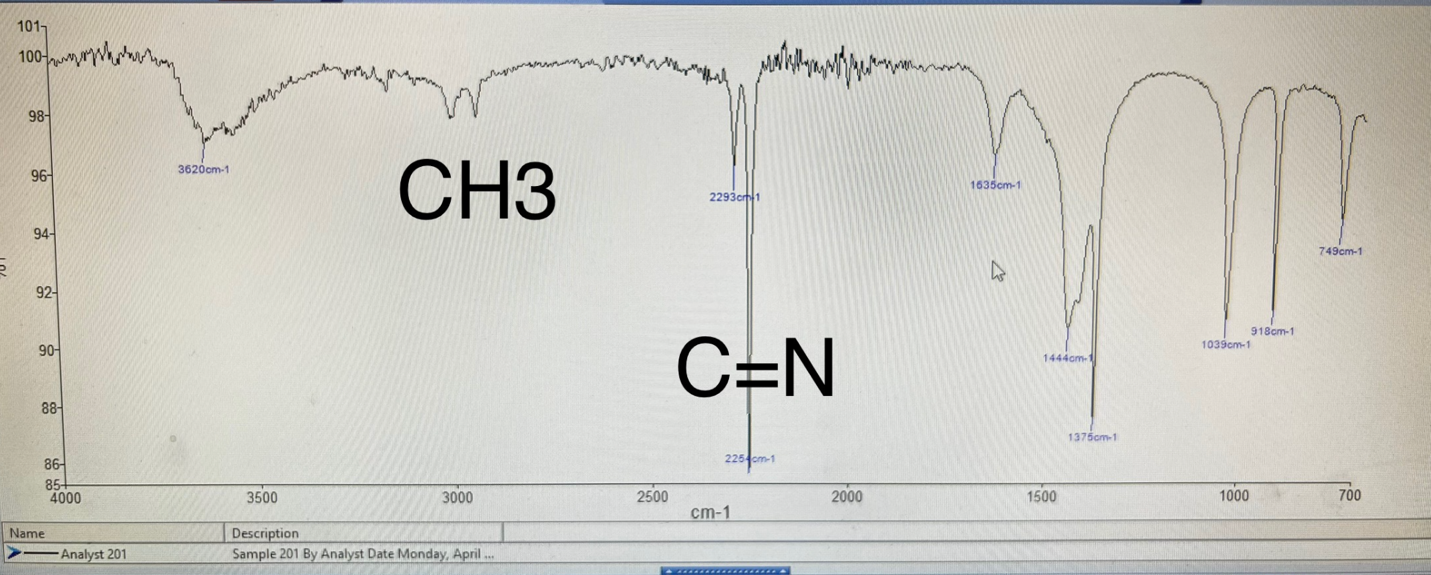Data
In the course of the present experiment, an infrared spectrum was obtained for an unknown substance, which allows qualitative identification by characteristic bands. As is known, each band on such a spectrum corresponds to an individual covalent bonding vibration; therefore, the study of the spectrum allows one to determine the nature of the substance under study almost unmistakably (Fomina et al., 2022). The spectrum obtained using the PerkinElmer Spectrum IR is shown in Fig. 1. It is clearly seen that the spectrum shows some peak bands at specific frequencies so that their study will make it possible to identify the substance. In particular, at 2960 cm-1, there is a peak for the C-H bond stretching. The apparent valence vibrations are the bond vibrations at 2250-2295 cm-1 — these bands characterize the presence of a -C≡N bond within the molecule. The absence of a C-H bond for alkene or alkyne compounds is remarkable, which means there are no similar bonds with hydrogen atoms in the molecule.

As part of the work, a list of potential substances was proposed, among which there is only one candidate for the role of an unknown compound. Each of the substances differs in chemical characteristics, so it was necessary to study their qualitative composition. So, based on the list provided, a table characterizing the functional groups and molecular features in the substances was created. As can be seen from Table 1, the main functional groups of this sample included oxygen-containing groups or amino groups, while four of the ten substances had aromatic rings in their composition.
Table 1: Qualitative Characteristics for the Ten Potential Compounds
Data Analysis
Based on the data obtained, it was possible to identify the substance that was more suitable for the role of unknown. For qualitative identification, knowledge of both the potential candidates for this role and the structural features of the molecule based on the results of infrared spectrometry were used. In particular, it was shown that there should be no multiple carbon covalent bonds in the substance, which means that all aromatic compounds did not fit this criterion. In addition, the infrared spectrum showed the presence of nitrogen in the compound since there was a noticeable oscillation of the nitrogen-carbon bond. Therefore, only Acetonitrile and Pentylamine remained among the potential candidates for the unknown compound. Formulas of both substances are shown in Fig. 2 below – it is noteworthy that Pentylamine lacks the -C≡N bond, which was detected by a spectrometric study. In other words, the substance sought is acetonitrile.

Acetonitrile is an organic micromolecular substance with the formula C2H3N. In terms of chemical classification, acetonitrile refers to nitriles, that is, derivatives of hydrocyanic acid with a methyl acetate radical instead of hydrogen (LibreTexts, 2020). Reference to reference databases provides the known infrared spectrum for acetonitrile shown in Figure 3. It is clearly seen that the reference spectrum perfectly corresponds to the spectrogram obtained in the present study. In other words, it is possible to postulate not only the competent determination of the substance in laboratory conditions but also its comparative purity resulting in the absence of additional bands.

References
ChemInfo. (n.d.). Web.
Fomina, P. S., Proskurnin, M. A., Mizaikoff, B., & Volkov, D. S. (2022). Infrared spectroscopy in aqueous solutions: Capabilities and challenges. Critical Reviews in Analytical Chemistry, 1-18.
LibreTexts. (2020). Nitriles. Chemistry LibreTexts. Web.